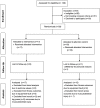The feasibility of an exercise intervention in males at risk of oesophageal adenocarcinoma: a randomized controlled trial
- PMID: 25706622
- PMCID: PMC4338269
- DOI: 10.1371/journal.pone.0117922
The feasibility of an exercise intervention in males at risk of oesophageal adenocarcinoma: a randomized controlled trial
Abstract
Objective: To investigate the feasibility and safety of a 24-week exercise intervention, compared to control, in males with Barrett's oesophagus, and to estimate the effect of the intervention, compared to control, on risk factors associated with oesophageal adenocarcinoma development.
Methods: A randomized controlled trial of an exercise intervention (60 minutes moderate-intensity aerobic and resistance exercise five days/week over 24 weeks; one supervised and four unsupervised sessions) versus attention control (45 minutes stretching five days/week over 24 weeks; one supervised and four unsupervised sessions) in inactive, overweight/obese (25.0-34.9 kg/m2) males with Barrett's oesophagus, aged 18-70 years. Primary outcomes were obesity-associated hormones relevant to oesophageal adenocarcinoma risk (circulating concentrations of leptin, adiponectin, interleukin-6, tumour necrosis factor-alpha, C-reactive protein, and insulin resistance [HOMA]). Secondary outcomes included waist circumference, body composition, fitness, strength and gastro-oesophageal reflux symptoms. Outcomes were measured at baseline and 24-weeks. Intervention effects were analysed using generalised linear models, adjusting for baseline value.
Results: Recruitment was difficult in this population with a total of 33 participants recruited (target sample size: n = 80); 97% retention at 24-weeks. Adherence to the exercise protocol was moderate. No serious adverse events were reported. A statistically significant intervention effect (exercise minus control) was observed for waist circumference (-4.5 [95% CI -7.5, -1.4] cm; p < 0.01). Effects on primary outcomes were not statistically significant.
Conclusion: This small, exploratory trial provides important information to inform future trial development including recruitment rates and estimates of effect sizes on outcomes related to oesophageal adenocarcinoma risk. Future trials should investigate a combined dietary and exercise intervention to achieve greater weight loss in this population and relax inclusion criteria to maximize recruitment.
Trial registration: Australian New Zealand Clinical Trials Registry (ANZCTR) ACTRN12609000401257.
Conflict of interest statement
References
-
- Vizcaino AP, Moreno V, Lambert R, Parkin DM (2002) Time trends incidence of both major histologic types of esophageal carcinomas in selected countries, 1973–1995. Int J Cancer 99: 860–868. - PubMed
-
- Lord RV, Law M, Ward R, Giles G, Thomas RJ, et al. (1998) Rising incidence of oesophageal adenocarcinoma in men in Australia. J Gastroenterol Hepatol 13: 356–362. - PubMed
-
- Blot WJ, Devesa SS, Kneller RW (1991) Rising incidence of adenocarcinoma of the esophagus and gastric cardia. JAMA 265: 1287–1296. - PubMed
Publication types
MeSH terms
Substances
Supplementary concepts
Associated data
LinkOut - more resources
Full Text Sources
Other Literature Sources
Medical
Research Materials


